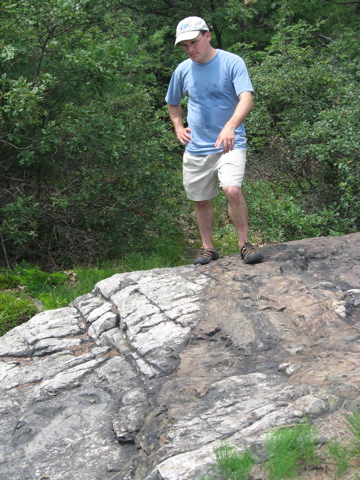Picture of a pond on the site of the old gabbro quarry.
Weathered Medford Gabbro
Weathered Lynn Felsite
The most common types of rock found in the Fells are "Medford Gabbro" and "Lynn Felsite" (a type of rhyolite). Observe how the two rocks weather, in the pictures above. What words would you use to describe the way each rock type weathers? Which rock type do you think weathers more easily?
Consider the different ways these two rock types form. How might this explain the differences in the ways that they weather?
Given the way the two rocks weather, what might that tell you about why the gabbro was quarried, and not the felsite?
If you were to wander through the park, you would notice a third type of rock, a dark rock called basalt. There are many places in the park where you see contact between the Lynn Felsite and the basalt. In these pictures, the whitish rock is the felsite, and the reddish/brown rock is the basalt (unexposed basalt is black or grey, but this rock weathers rusty color due to the iron minerals in it).
Study the pictures below. What patterns do you observe? What clues are present that might help you determine which rock came first (the felsite or the basalt)?




The pictures below show a large roadcut along Route 93, which cuts right through the Fells park. Notice dark bands of basalt and the much ligher Lynn Felsite.
With this additional information, can you now tell which rock came first?
It's interesting to note that you can't find the basalt cutting through the Medford gabbro. What does that suggest about when the gabbro formed, compare to the other two types of rock.







